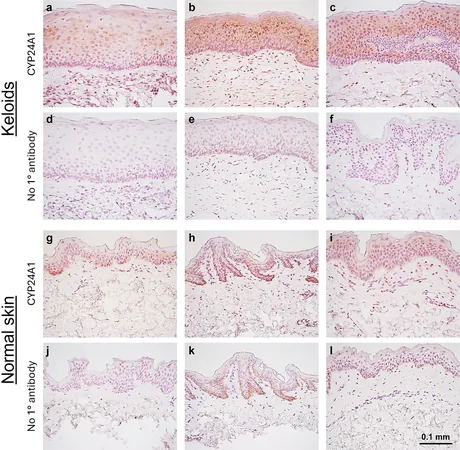
Breakthrough in Keloid Scar Treatment: How Vitamin D Enzyme Inhibition Could Change Lives!
2025-01-22
Author: Rajesh
Understanding Keloid Scars
Keloids, those frustrating and often unsightly fibrotic scars that extend beyond the original wound, can be a source of considerable physical distress and emotional turmoil for many individuals. Their formation is primarily driven by an excessive production of extracellular matrix components, particularly type I collagen, which arises from an imbalance in the body's tissue repair mechanisms. For those struggling with keloids, current treatment options are limited and often fall short due to a lack of understanding of the underlying molecular processes involved in their formation.
Recent Research Findings
Recent research published in the esteemed journal *Burns & Trauma* has unveiled an exciting pathway forward. A team at the University of Cincinnati has discovered that inhibiting CYP24A1, an enzyme central to vitamin D metabolism, significantly influences the behavior of keloid keratinocytes. This groundbreaking study opens new avenues for potential treatments that could redefine how keloids are managed.
Innovative Research Methodology
In their innovative approach, the researchers isolated primary keratinocytes from both normal and keloid skin samples. They then cultured these cells with and without vitamin D and tested inhibitors such as ketoconazole and VID400. The results were illuminating: keloid keratinocytes exhibited a marked overexpression of CYP24A1 at both mRNA and protein levels.
Effects of Inhibitors
Interestingly, while ketoconazole demonstrated a broad reduction in cell proliferation, VID400 showed a targeted effect, inhibiting the growth of keloid keratinocytes without affecting their ability to migrate. Both inhibitors were effective in lowering the expression of profibrotic genes like periostin and hyaluronan synthase 2, which are crucial players in keloid development. When these inhibitors were combined with vitamin D, researchers noted an amplification of their effects, hinting at their potential as adjunct therapies for keloid patients.
Expert Insights
Dr. Dorothy M Supp, the senior author of the study, emphasized the transformative nature of these findings: "Identifying CYP24A1 as a key factor in keloid keratinocytes marks a paradigm shift in dermatology. Our study not only enhances understanding of the molecular mechanisms driving keloid formation but also paves the way for targeted therapies. By modulating CYP24A1's activity, we have the potential to improve treatment efficacy and address the recurring issues patients face, heralding a new era in keloid management."
Future Implications
The ramifications of this research could extend far beyond just immediate treatment options. By bringing attention to CYP24A1’s critical role in keloid pathology, this study signifies a crucial shift from merely reactive treatment strategies to proactive prevention methods. As we await further developments in clinical applications, this research may soon provide hope to countless individuals grappling with the challenges posed by keloid scars.
Conclusion
Stay tuned as promising advancements in dermatology offer a glimpse into a future where keloids are managed more effectively, allowing patients to reclaim their skin and confidence!


 Brasil (PT)
Brasil (PT)
 Canada (EN)
Canada (EN)
 Chile (ES)
Chile (ES)
 Česko (CS)
Česko (CS)
 대한민국 (KO)
대한민국 (KO)
 España (ES)
España (ES)
 France (FR)
France (FR)
 Hong Kong (EN)
Hong Kong (EN)
 Italia (IT)
Italia (IT)
 日本 (JA)
日本 (JA)
 Magyarország (HU)
Magyarország (HU)
 Norge (NO)
Norge (NO)
 Polska (PL)
Polska (PL)
 Schweiz (DE)
Schweiz (DE)
 Singapore (EN)
Singapore (EN)
 Sverige (SV)
Sverige (SV)
 Suomi (FI)
Suomi (FI)
 Türkiye (TR)
Türkiye (TR)
 الإمارات العربية المتحدة (AR)
الإمارات العربية المتحدة (AR)